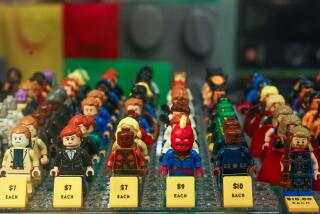To Fanciers of Small Wonders, Danish ‘Disneyland’ Has ‘Lego’ Up on Competition
- Share via
BILLUND, Denmark — The capital city of a plastic-brick empire lies on an isolated 24-acre patch of heath in western Denmark.
It has attracted 16 million visitors--more than three times the Danish population--since its founding 20 years ago.
It is Legoland, Scandinavia’s answer to Disneyland, a miniature landscape where famous cities and monuments of the world are accurately reconstructed at waist-high level in pollution-resistant, non-scratch plastic, courtesy of the LEGO Toy Co.
“We have many schools doing geography tours, because they can see in quite a small area what different styles are like,” spokesman Holger Henriksen said.
Miniature Towns
The Acropolis is here, in plastic but cleaner and safer from acid rain and car exhaust fumes than in its native Athens.
The typical old English town called Medbourne isn’t on any British map. It is an amalgam of half-timbered buildings from York, Chester and Stamford, yet more perfectly laid out than any of them.
Visitors can dream through the German Rhineland, with its castle, or along the miniature waterways of an artificial Amsterdam.
From the side of a Mt. Rushmore rising to about 10 yards, the plastic U.S. presidential heads of Washington, Jefferson, Lincoln and Roosevelt stare down at a scene startlingly different than the one they enjoy in South Dakota.
Bonsai Specialists
The tiny towns are also an attraction for specialists in miniature Bonsai gardening, as the civic plants must grow in proportion to the buildings.
About 33 million plastic bricks have been linked to produce this fantasy world since the then-LEGO company director Godtfred Kirk Christiansen hit on the idea of Legoland, which opened in 1968 next to the firm’s headquarters.
His father, Ole, started the firm by making wooden toys in 1932, inventing the name LEGO from the Danish Leg Godt , meaning “play well.” Since plastic bricks were included in the range in 1949, the company has spread to five continents.
Six out of 10 visitors come from abroad. And, Henriksen said, about 60% of these named Legoland as their main reason for coming to Denmark. “We were amazed ourselves,” he said.
Adults Attracted
Less than a third of the visitors are children. Youngsters prefer the many activities offered by Legoland to looking at models.
They can take a realistic driving test, visit a Wild West town or roll through a “safari park” inhabited by plastic lions and elephants, frozen in their natural poses.
Legoland’s teams of designers go to the original buildings and monuments for accurate measurements before consigning them to plastic.
Then they match the colors and styles from the standard range of more than 1,300 types of brick, though special bricks are occasionally molded to get the right shades.
But what is the attraction of plastic stones, when many visitors could go and see the real thing for the same money? Henriksen’s explanation was simple, “People like to dream.”
More to Read
Sign up for The Wild
We’ll help you find the best places to hike, bike and run, as well as the perfect silent spots for meditation and yoga.
You may occasionally receive promotional content from the Los Angeles Times.






